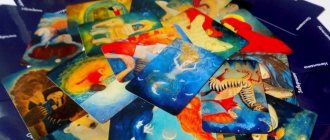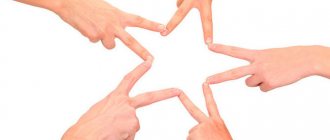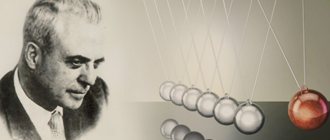Calibration
Film "Casino Royale"
Do you notice the tick?
They used to say - a very attentive interlocutor, observant, notices everything in a conversation! Now they say the same thing: “calibrates perfectly”!
Calibration is careful observation of the small details of a person’s condition and behavior, clarifying our vision of his condition. Calibration is used for more effective adjustment and management; calibration data helps to better understand what a person really thinks and feels, even if he is not inclined to talk about his condition or, moreover, is playing a double game.
What does calibration do? It is best to cite quotes and examples from the work of students at the University of Practical Psychology, which they wrote as reports on the results of training this wonderful skill.
Writes B. Nelya
My youngest daughter, she is 14 years old, raised her T-shirt in front of the mirror and in a loud voice, attracting my attention, said: Mom, I’m so fat! What I observe: Gyulchatay zone 1: the center of the eyebrows is raised (some surprise), wrinkles between the eyebrows (intensifies the moment), the nose is turned up, the corners of the lips are lowered down. The eyes are curious and cunning. They already have an answer prepared for me: well, you’re Yanochka, you’re thin and beautiful. I set up an experiment and answer: now I’ll call the fitness club and find out what time the trainer is free. Next is an oil painting: the first reaction is bewilderment, the folds on the forehead are horizontal, the eyes are large and round (not what I expected to hear), the mouth is slightly open. Surprise and bewilderment.
Writes L. Sergey
I chose my wife, director and administrator as those to be calibrated. We have been married for 30 years, what new can I see in my wife? Intuitively, unconsciously, even from micromovements, from the first word, I know what she is saying and why. But after consciously observing her facial expressions and gestures, I realized that there was still a lot I didn’t know about her. She can speak kindly, the right words and eyes can be kind, but if I see a wrinkle on her forehead, it means she’s angry; if gestures are added (usually pointing, but sometimes there is just fussiness of movements) it means that she is indignant and wants to actively influence. When she analyzes something, her eyes narrow and begin to dart from side to side.
Pleasure is expressed in a slight smile without exposing the teeth, the corners of the lips turn up strongly, there is a fold under the eyes, the cheeks rise up, and so-called crow's feet form in the outer corners of the eyes. When surprised, the eyes widen, folds appear on the forehead and the mouth opens slightly.
When she doesn’t believe me, her face seems to gather towards the center: her lips are in a tube, her cheeks are pulled up, her nose is wrinkled, her eyes are squinted, there are folds on her forehead...
Writes M. Svetlana
Private security department, I’m waiting near the office for the end of the afternoon break. Time has expired, but no one is there. About twenty minutes later a woman appears and notices me waiting for her arrival. The movements of the arms become fussy, the shoulders slouch a little, the head is pulled into the shoulders. The face tenses, wrinkles appear on the forehead, the eyebrows are slightly drawn down to the bridge of the nose. “Are you coming to me?” is the question. In the intonation one can hear wariness and hope that this is not so. “Yes,” I say calmly. - "To you". He begins to fuss even more, quickly undresses and begins to rearrange some documents, straining his forehead and the bridge of his nose, and a vein in his neck is pulsating. The phone rings, the employee quickly picks up the phone, answers it and looks at me a little scared.
I calmly explained the essence of my question and noticed with satisfaction that the woman gradually calmed down, seeing that I was not going to reprimand her or blame her for being late. The movements slowed down, the shoulders straightened, a slight smile touched the lips.
Another office. To resolve the next issue, I turned to a pleasant woman with a request to help terminate the contract in the absence of the relative in whose name the document was drawn up. He was being treated in hospital and could not attend, but handed over his passport and payment receipts.
At first, the first reaction was according to the protocol: “That’s not how it’s supposed to be.” The face and voice are stern, without emotion, the body is frozen and selected. I didn’t argue, I just asked to delve a little deeper into the situation and give advice. After a couple of minutes, the body relaxed, the hand supported the chin, the gaze warmed, the eyebrows rose, dragging the upper eyelids with them, small wrinkles gathered in the corners of the eyes, a dimple on the left cheek became noticeable, the chin rose slightly. Notes of sympathy were heard in the voice: “Well, okay, write a statement.”
While I was writing the statement, my face changed again. It became a little thoughtful, looking absent for a few seconds. Apparently it inspired something of its own. “Yes, anything can happen in life,” it sounded softly in the silence. Having sincerely thanked you for your understanding, I went home.
Writes S. Tatyana
One day my son and I were sitting in a cafe, and while he was chewing his sandwich, washing it down with a sweet drink, I decided not to waste time and try to calibrate the woman sitting opposite us.
She sat with her side to us, and we could calmly look at her, without fear that the woman would become embarrassed under my gaze. The woman turned out to be an interesting specimen to observe. She sat with an upright posture, one might say, in a calm presence - a minimum of gestures, without unnecessary fuss. She is dressed quite simply and tastefully - a long plain skirt, a silk jacket with a flower pattern. She constantly looked out the window and was focused on her own thoughts. On the table, next to her purse, lay a swollen diary. I noticed her gestures, they were collected and at the same time very neat, I would say, aristocratic and refined. Finishing her coffee, she wiped her hands with a napkin. She took out a mirror and checked her makeup. Movements are clear and coordinated. I put the mirror and the remaining clean napkins in my purse.
At that time I was thinking, who could this woman work as? Having listed several options, I settled on the fact that she is very similar to a teacher at a university. Watching her, it seemed to me that she was exactly the person who was used to speaking in front of an audience - her gaze was calm, but at the same time collected, her gestures were leisurely but clear. It is clear that he is a respected person and knows his worth. I also thought that she probably had some kind of academic degree.
All that remained was to somehow find out about my guess. When the woman stood up, she found herself very close to our table. Her gaze fell on me, and I decided: “Excuse me, but aren’t you a teacher at a university?” There was surprise in her eyes. She confirmed: “Yes, indeed, I am a teacher, in addition, I am the head of a department at a university, and in addition, an associate professor. And what?" I had to admit that I was a student of the Faculty of Psychology, and I was completing a study assignment - reading information from a stranger. She praised me for my powers of observation. And I thought that by carefully observing a person, his movements, gestures, facial expressions, posture, you can learn a lot about his character, profession, status, marital status, even before the person begins to speak.
You just need to be able to read it...
As a Distance exercise, the “Calibration” exercise teaches you to see the emotions and mood of people (including your own emotions) in the process of communication and distinguish lies from the truth. The exercise is practiced in a variety of practices, and the OZR (the volume of the planned result) is formulated (for example) in this way.
I have developed the skill of observation, 90% of 100% of the time confident contact with a person: I know how and what to look at in order to determine the internal state of a person; I see what exactly stands behind the words that the interlocutor tells you; I distinguish the manifestation of a person’s emotions from other “noise signals”; I understand where this or that emotion comes from, how long it lasts and how it subsides; I see the motives and reasons for people’s actions.
Exercises and practices to help master the skill of calibration:
"Gyulchatai"
General task: when transmitting any information (not/corresponding to reality), to track in the first seconds changes in a person’s facial expressions across floors. At the same time, we cover other parts of the face (tablet, sheet of paper, etc.).
- Upper floor (micro movements of the head, movements of the eyebrows, facial wrinkles on the forehead, skin color, movement of the skin under the hair).
- Middle floor (movements of the cheekbones, corners of the eyes, size of the eyes and pupils, squinting, eyelid tension, blinking, movement of the wings of the nose, movement of the muscles under the wings of the nose).
- Lower floor (cheekbones, lips, chin, neck).
"Headless horseman"
Task: when transmitting any information (not/corresponding to reality), track changes in the human body in the first seconds. At the same time, we cover our face (tablet, sheet of paper, etc.). Parameters: breathing, body swaying, freezing, “ripples” across the body, relieved/heavy sigh, laryngeal movements, skin color.
"Telepathy"
The exercise is done in pairs. The first number, having previously calibrated the partner’s body and facial expressions on simple questions, produces statements about the second. For example, “There’s a cat at your house” (says something he doesn’t know about the second number). Based on the body parameters of the second participant, the first number determines whether this statement applies to the partner or not.
Actor facial expression tracking
How? Watch a good, quality movie...
What is the benefit, value, necessity of NLP calibration skill?
The thing is, some people react in a very obvious way. But not all... Others express themselves in a clouded, atypical way.
When learning the skill of NLP calibration, it is important to learn the most important thing first - learn to recognize when a person tells you (without words) YES, and when - No (also without words). Because sometimes we love to “put pressure” on people without seeing or hearing their obvious non-verbal signals, and then this leads to failures of all kinds..
Because sometimes we love to put pressure on people without seeing or hearing their obvious non-verbal signals, and then this leads to failures of all kinds...
Here are just some nonverbal ways to say yes and no.
- While thinking “no” to themselves, some people unconsciously tense their jaw muscles and relax them while thinking “yes.”
- Thinking “no” makes some people turn pale, while thinking “yes” makes them blush.
- Thinking “no”, some people lean back, and thinking “yes”, they lean their body towards us.
The “adjustment” method and rapport
Establishing rapport means “joining” a person, tuning into his body language, carefully and unnoticeably.
You can adapt to the movement of your hands with a subtle movement of your hand, and to the movements of your body with the help of movements of your head or body. They often adapt to the interlocutor’s posture and manner of movement.
Finished works on a similar topic
- Course work NLP methods 490 rub.
- Abstract NLP methods 230 rub.
- Test work NLP methods 250 rub.
Receive completed work or specialist advice on your educational project Find out the cost
A powerful way to establish rapport is to adjust your breathing and the frequency of your eye blinks. When communication occurs in strong rapport, then they can breathe and blink in unison with each other.
Matching the conversation is a good method for establishing rapport. You can tune in to the tone, tempo, volume or rhythm of speech.
Addition - changes in role models of behavior, mutual complementation of each other occurs. For example, I am a Child and you are a Child - this is an adjustment position, and if I am a Parent and you are a Child, then this is an extension. Or else, you can sit next to him, sit down so that it’s nice and comfortable.








